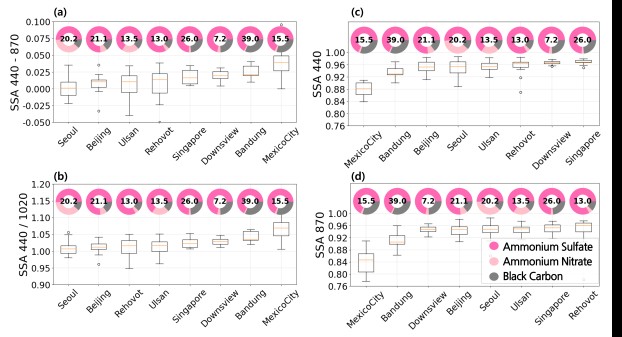Abstract
Severe fine dust pollution over Seoul and Mexico City, being composed of the same type of fine particulate matter (PM2.5), exhibits markedly different characteristics. Seoul's air tends to reflect sunlight, contributing to a cooling effect on the Earth, whereas Mexico City's particles are more inclined to absorb sunlight, potentially accelerating global warming.
A research team led by Professor Sang Seo Park from the Department of Civil, Urban, Earth and Environmental Engineering at UNIST analyzed chemical samples and optical data of PM2.5 collected from 14 cities around the world. Their findings reveal notable differences in the optical and chemical characteristics of fine particles in these two urban environments.
According to the study, Seoul's fine particulate matter has a high proportion of sulfate and nitrate compounds, which tend to strongly scatter sunlight, exhibiting a 'reflective (albedo)' nature. In contrast, Mexico City has a relatively higher presence of black carbon-soot-that absorbs sunlight, displaying an 'absorptive' property. This means that, even with the same PM2.5 levels, Seoul's particles reflect sunlight back into space, exerting a cooling influence, while particles in Mexico City absorb solar energy, potentially accelerating local warming.
 Figure 1. Pie charts of the mass ratios of fine particles (AS, AN, and BC) and boxplots of their corresponding (a) dSSAw (SSA440-SSA870), (b) rSSA (SSA440/SSA1020), (c) SSA440, and (d) SSA870 values.
Figure 1. Pie charts of the mass ratios of fine particles (AS, AN, and BC) and boxplots of their corresponding (a) dSSAw (SSA440-SSA870), (b) rSSA (SSA440/SSA1020), (c) SSA440, and (d) SSA870 values.
The research compared chemical composition data (SPARTAN) and optical measurements (AERONET)-a ground-based network that assesses how sunlight is scattered and absorbed as it passes through the atmosphere-from 14 cities worldwide, including Seoul, Beijing, and Mexico City. AERONET data enables estimation of particulate matter concentration based on how much sunlight is dimmed and scattered by atmospheric aerosols.
Results indicated that a higher ratio of scattering components, such as sulfate and nitrate, correlates with increased Single Scattering Albedo (SSA) values. SSA quantifies the proportion of light reflected versus absorbed by airborne particles; values approaching 1 signify predominantly scattering particles, while lower values indicate higher absorption. The study found that as the number of absorbing components like black carbon increased, SSA decreased, especially at longer wavelengths (870-1020 nm). Additionally, larger amounts of soil dust led to rapid changes in wavelength-dependent scattering properties (dSSA and rSSA).
Sujin Eom, the first author of the study, explained, "This research demonstrates, through direct measurements rather than modeling, how differences in chemical composition influence the optical behavior and climate effects of aerosols. It highlights the importance of considering not just PM2.5 concentrations but also their composition in air quality and climate studies."
Professor Park added, "Our findings establish a basis for indirectly estimating the toxicity differences of fine particles based on their optical properties. This approach can enhance the accuracy of air quality forecasts and inform public health policies."
This joint research was conducted in collaboration with the UNIST Particle Pollution Research and Management Center and published in the journal, Environmental Science & Technology (Impact Factor=11.3) on September 12, 2025.
Journal Reference
Sujin Eom, Sang Seo Park, Xuan Liu, et al., "Impact of Chemical Composition on Aerosol Scattering: Insights from the Surface Particulate Matter Network and Aerosol Robotic Network," Environ. Sci. Technol., (2025).






